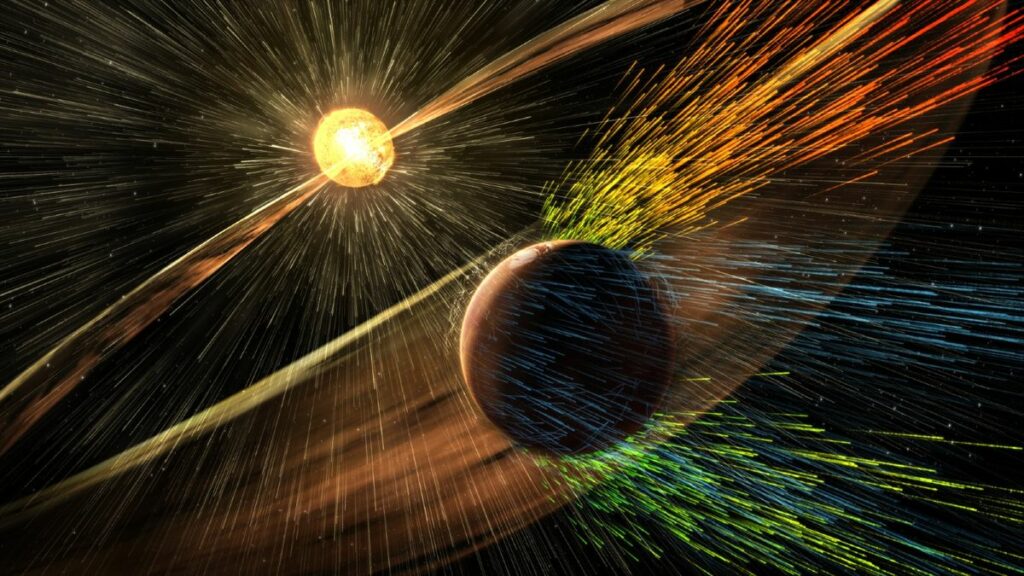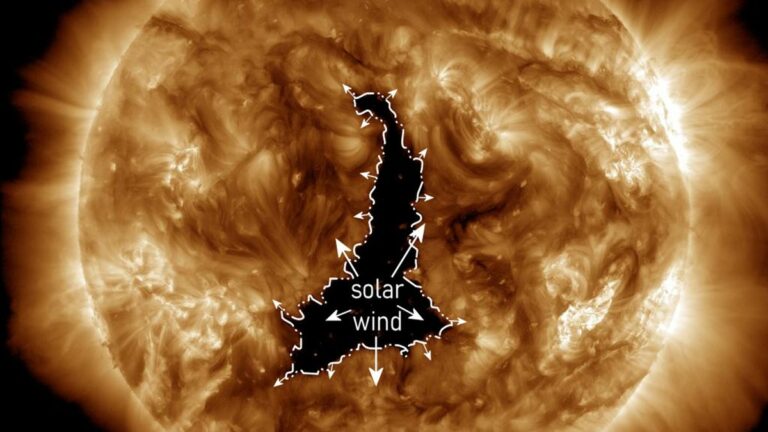Enormous Solar Opening, Over 60 Times Earth’s Width, Ejects Rapid Solar Wind Toward Earth
A colossal dark region, identified as a coronal hole, has recently emerged near the sun’s equator. This transient gap is facilitating the acceleration of exceptionally swift solar wind directed towards Earth.
A massive, dark void has emerged on the surface of the sun, unleashing potent streams of exceptionally fast radiation, referred to as solar wind, directly towards Earth. Scientists note that the size and alignment of this temporary opening, exceeding the width of 60 Earths, represent an unprecedented occurrence during this stage of the solar cycle.
This immense dark region, identified as a coronal hole, took form near the sun’s equator on December 2, swiftly expanding to its maximum width of approximately 497,000 miles (800,000 kilometers) within 24 hours, as reported by Spaceweather.com. Since December 4, the solar void has been directly aimed at Earth.
Coronal holes manifest when the sun’s magnetic fields, responsible for holding it in place, abruptly open up, causing the upper surface’s contents to stream away as solar wind, according to the National Oceanic and Atmospheric Administration (NOAA). These holes appear as dark patches because they are cooler and less dense than the surrounding plasma, similar to the reason sunspots seem black. However, unlike sunspots, coronal holes are only visible in ultraviolet light.
The radiation emanating from coronal holes surpasses the speed of normal solar wind and often triggers disturbances in Earth’s magnetic shield, leading to geomagnetic storms, as noted by NOAA. The most recent coronal hole, appearing in March, resulted in the most powerful geomagnetic storm to impact Earth in over six years.
Initial predictions suggested that this latest opening could induce a moderate (G2) geomagnetic storm, potentially causing radio blackouts and vibrant auroral displays for several days. However, the solar wind’s intensity has been lower than anticipated, resulting in a milder (G1) storm so far, according to Spaceweather.com. Nevertheless, the possibility of auroras persists.
The duration of the hole’s presence in the sun remains uncertain, but historical data from NOAA indicates that previous coronal holes have endured beyond a single solar rotation (27 days). Nonetheless, the hole is expected to rotate away from Earth in the near future.

Throughout the year, solar activity has been on the rise as the sun approaches the climax of its approximately 11-year solar cycle, known as the solar maximum. However, in an unexpected turn, the emergence of the colossal new coronal hole is not anticipated as part of the typical increase in solar activity.
Coronal holes can manifest at any point during the solar cycle, but they are more commonly observed during solar minimum, as stated by NOAA. When they do appear during solar maximum, they typically occur near the sun’s poles rather than in proximity to the equator. The presence of such a massive hole near the equator, especially as we approach the solar maximum, poses a perplexing mystery.
Nevertheless, over the past few weeks, several other indicators have pointed to increased solar activity. On November 18, a substantial “sunspot archipelago” formed, comprising at least five distinct sunspot groups on the sun’s near side, subsequently emitting numerous solar storms into space. On November 25, an explosive eruption described as a “canyon of fire” occurred near the sun’s equator, resulting in a coronal mass ejection (CME) — a swiftly moving cloud of magnetized plasma — which impacted Earth, leading to rare orange auroras. Additionally, on November 28, an “almost X-class” solar flare erupted from the sun, giving rise to a cannibal CME that reached Earth and induced a geomagnetic storm, illuminating lower latitudes with auroras over the weekend.
The recent surge in solar activity suggests that we are on the verge of reaching the solar maximum. In October, scientists adjusted their solar cycle forecasts, now anticipating that the explosive peak could commence in early 2024.
This article is republished from LiveScience under a Creative Commons license. Read the original article.
Do not forget to share your opinion with us to provide you with the best posts !




0 Comments